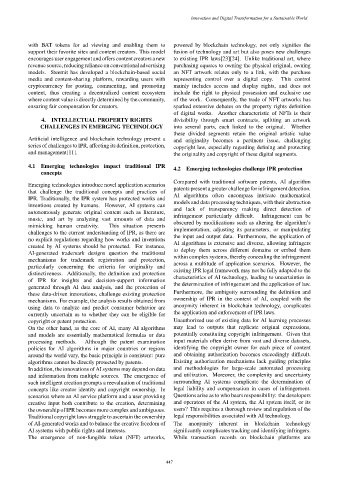Page 491 - Kaleidoscope Academic Conference Proceedings 2024
P. 491
Innovation and Digital Transformation for a Sustainable World
with BAT tokens for ad viewing and enabling them to powered by blockchain technology, not only signifies the
support their favorite sites and content creators. This model fusion of technology and art but also poses new challenges
encourages user engagement and offers content creators a new to existing IPR laws[23][24]. Unlike traditional art, where
revenue source, reducing reliance on conventional advertising purchasing equates to owning the physical original, owning
models. Steemit has developed a blockchain-based social an NFT artwork relates only to a link, with the purchase
media and content-sharing platform, rewarding users with representing control over a digital copy. This control
cryptocurrency for posting, commenting, and promoting mainly includes access and display rights, and does not
content, thus creating a decentralized content ecosystem include the right to physical possession and exclusive use
where content value is directly determined by the community, of the work. Consequently, the trade of NFT artworks has
ensuring fair compensation for creators. sparked extensive debates on the property rights definition
of digital works. Another characteristic of NFTs is their
4. INTELLECTUAL PROPERTY RIGHTS divisibility through smart contracts, splitting an artwork
CHALLENGES IN EMERGING TECHNOLOGY into several parts, each linked to the original. Whether
these divided segments retain the original artistic value
Artificial intelligence and blockchain technology present a and originality becomes a pertinent issue, challenging
series of challenges to IPR, affecting its definition, protection, copyright law, especially regarding defining and protecting
and management[11]. the originality and copyright of these digital segments.
4.1 Emerging technologies impact traditional IPR
4.2 Emerging technologies challenge IPR protection
concepts
Compared with traditional software patents, AI algorithm
Emerging technologies introduce novel application scenarios
patents present a greater challenge for infringement detection.
that challenge the traditional concepts and practices of
AI algorithms often encompass intricate mathematical
IPR. Traditionally, the IPR system has protected works and
models and data processing techniques, with their abstraction
inventions created by humans. However, AI systems can
and lack of transparency making direct detection of
autonomously generate original content such as literature,
infringement particularly difficult. Infringement can be
music, and art by analyzing vast amounts of data and
obscured by modifications such as altering the algorithm’s
mimicking human creativity. This situation presents
implementation, adjusting its parameters, or manipulating
challenges to the current understanding of IPR, as there are
the input and output data. Furthermore, the application of
no explicit regulations regarding how works and inventions
AI algorithms is extensive and diverse, allowing infringers
created by AI systems should be protected. For instance,
to deploy them across different domains or embed them
AI-generated trademark designs question the traditional
within complex systems, thereby concealing the infringement
mechanisms for trademark registration and protection,
across a multitude of application scenarios. However, the
particularly concerning the criteria for originality and
existing IPR legal framework may not be fully adapted to the
distinctiveness. Additionally, the definition and protection
characteristics of AI technology, leading to uncertainties in
of IPR for insights and decision-support information
the determination of infringement and the application of law.
generated through AI data analysis, and the protection of
Furthermore, the ambiguity surrounding the definition and
these data-driven innovations, challenge existing protection
ownership of IPR in the context of AI, coupled with the
mechanisms. For example, the analysis results obtained from
anonymity inherent in blockchain technology, complicates
using data to analyze and predict consumer behavior are
the application and enforcement of IPR laws.
currently uncertain as to whether they can be eligible for
copyright or patent protection. Unauthorized use of existing data for AI learning processes
On the other hand, as the core of AI, many AI algorithms may lead to outputs that replicate original expressions,
and models are essentially mathematical formulas or data potentially constituting copyright infringement. Given that
processing methods. Although the patent examination input materials often derive from vast and diverse datasets,
policies for AI algorithms in major countries or regions identifying the copyright owner for each piece of content
around the world vary, the basic principle is consistent: pure and obtaining authorization becomes exceedingly difficult.
algorithms cannot be directly protected by patents. Existing authorization mechanisms lack guiding principles
In addition, the innovations of AI systems may depend on data and methodologies for large-scale automated processing
and information from multiple sources. The emergence of and utilization. Moreover, the complexity and uncertainty
such intelligent creation prompts a reevaluation of traditional surrounding AI systems complicate the determination of
concepts like creator identity and copyright ownership. In legal liability and compensation in cases of infringement.
scenarios where an AI service platform and a user providing Questions arise as to who bears responsibility: the developers
creative input both contribute to the creation, determining and operators of the AI system, the AI system itself, or its
the ownership of IPR becomes more complex and ambiguous. users? This requires a thorough review and regulation of the
Traditional copyright laws struggle to ascertain the ownership legal responsibilities associated with AI technology.
of AI-generated works and to balance the creative freedom of The anonymity inherent in blockchain technology
AI systems with public rights and interests. significantly complicates tracking and identifying infringers.
The emergence of non-fungible token (NFT) artworks, While transaction records on blockchain platforms are
– 447 –

